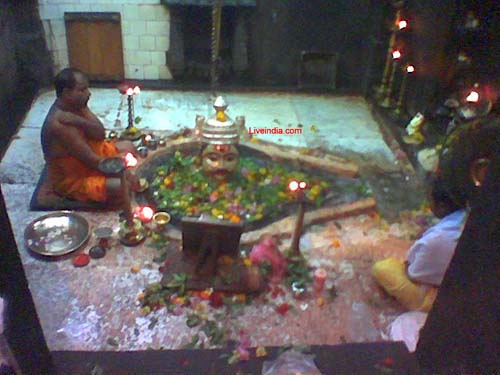
Tryambakeshwar located near at a distance of about 30 km from Nasik in Maharashtra is revered as one of the 12 Jyotirlinga shrines of Shiva. Tryambakeshwar is the source of the river Godavari. This is an ancient shrine, however the current structure is a result of the reconstruction efforts undertaken by the Peshwa Balaji Bajirao in mid 18th century. The other Jyotirlinga shrines in Maharashtra are Bhimashankar and Grishneshwar.
Legend has it that Gowtama muni resided on the Bhramagiri hill here with his wife Ahalya, and by virtue of his devotion received from Varuna, a bottomless pit from which he received an inexhaustible supply of grains and food. The other rishis, jealous of his fortune, arranged for a cow to enter his granary, and caused it to die as Gowtama attempted to ward it off with a bunch of Darbha grass.
Gowtama therfore worshipped Shiva, to bring the Ganga down to his hermitage to purify the premises. The Ganga came down as Godavari, and Shiva took up an abode here in the form of Tryambaka. Interestingly, locals refer to the river here as Ganga and not as Godavari. (Shown above is an image of the Ganga at Haridwar). All the heavenly Gods promised to come down to Nasik, once in twelve years, when Jupiter resides in the zodiac sign of Leo.
The legend relating to the Lingodbhava manifestation of Shiva also prevails here. Legend has it that Bhrama and Vishnu searched in vain to discover the origin of Shiva who manifested himself as a cosmic column of fire. Bhrama lied that he had seen the top of the column of fire, and was hence cursed that he would not be worshipped on earth. In turn Bhrama cursed Shiva that he would be pushed underground. Accordingly, Shiva came down under the Bhramagiri hill in the form of Tryambakeshwar. Circumambulating the Bhramagiri hill is considered sacred. (Please also see the Arunachala Hill, and the legend associated with the Origin of Linga worship).
Tryambakeshwar has been referred to in the Padma Purana. The Bhramagiri hill in Tryambakeshwar is referred to in the literature of Marathi saints. This shrine enjoyed of the patronage of the Peshwa rulers.
The Temple: This templebuilt of blak stone in the Nagara style of architecture is enclosed in a spacious courtyard. The sanctum internally a square and externally a stellar structure houses a small Shivalingam - Tryambaka. The sanctum is crowned with a graceful tower, crowned with a giant amalaka and a golden kalasha.
In front of the garbagriha and the antarala is a mandap with doors on all four sides. Three of these doorways are covered with porches, and the openings of these porches are ornamented with pillars and arches. The roof of the mandapam is formed by curvilinear slabs rising in steps. The entire structure is ornamented with sculptural work featuring running scrolls, floral designs, figures of gods, yakshas, humans and animals.
The Shivalingam is seen in a depression on the floor of the sanctum; water constantly oozes out from the top of the Shivalingam.Usually, the Shivalingam is covered with a silver mask, and on festive occasions with a golden mask with five faces, each with a golden crown. The sivler mask is equivalent to the processional images seen in South Indian temples.
Thirthas: Legend has it that the Ganga (Godavari) appeared and reappeared several times in response to the pleas of Gowtama Rishi, and there are several thirthas associated with these legends. The Gangadwara thirtha is believed to be the site where Ganga emerged. Varaha thirth is where Vishnu in the form of Varaaha took a bath in the Ganga (Godavari).
The Kushavarta thirtha is a tank with flights of steps on all sides, with pillared aisles with highly ornate arches. This is considered to be the holiest of all the thirthas here, and is believed to be the spot where Gowtama Rishi finally secured Ganga on earth by spreading the Kusha or the Darba grass around her. The structure around this thirtha was constructed by Raoji Abaji Parnekar (of the Holkars of Indore) in late 18th century.
Other thirthas here are the Gangasagar the Gautamalaya, Bilva thirtha, Indra thirtha, Vishwanath thirtha, Mukund thirtha, Prayag thirtha,Rama Kund, Lakshmana Kund etc. The confluence of the rivers Ahalya and Godavari is also held in reverence.
Other shrines: Kolhambika is a temple dedicated to Parvati, where she is believed to have slain the demon Kolhasura who had swallowed the Ganga river. Also here is the Ganga Devi temple enshrining a white marble image of Ganga. This temple was built in 1879. Other shrines here include those to Kedarnath, Rameshwar, Gowtameshwar, Kashi Vishwanath, Jareshwar, Kanchaneshwar, Tribhuvaneshwar, Rama, Parasurama, Krishna, Balaji, Lakshmi Narayan and Hanuman.
Worship services: Three worship services are carried out each day. During the nightly worship service sheja-aarti is carried out and the silver mask is placed in a bed in the hall of mirrors.
Each Monday, the silver mask of Tryambaka is placed in a palanquin and taken in procession to Kushavarta theertha and given an abhisheka there. This procession with the special golden mask, happens also on Shiv ratris, full moon day in the month of Kartika and during other festive occasions.
Simhasta Parvani which occurs once in every 12 years, when Jupiter enters the zodiac sign of Leo, is a time of great festivity when it is believed that all sacred waters gather in the Kushavarta thirtha. The Ganga avatarana festival is celebrated in the month of Magha
No comments:
Post a Comment